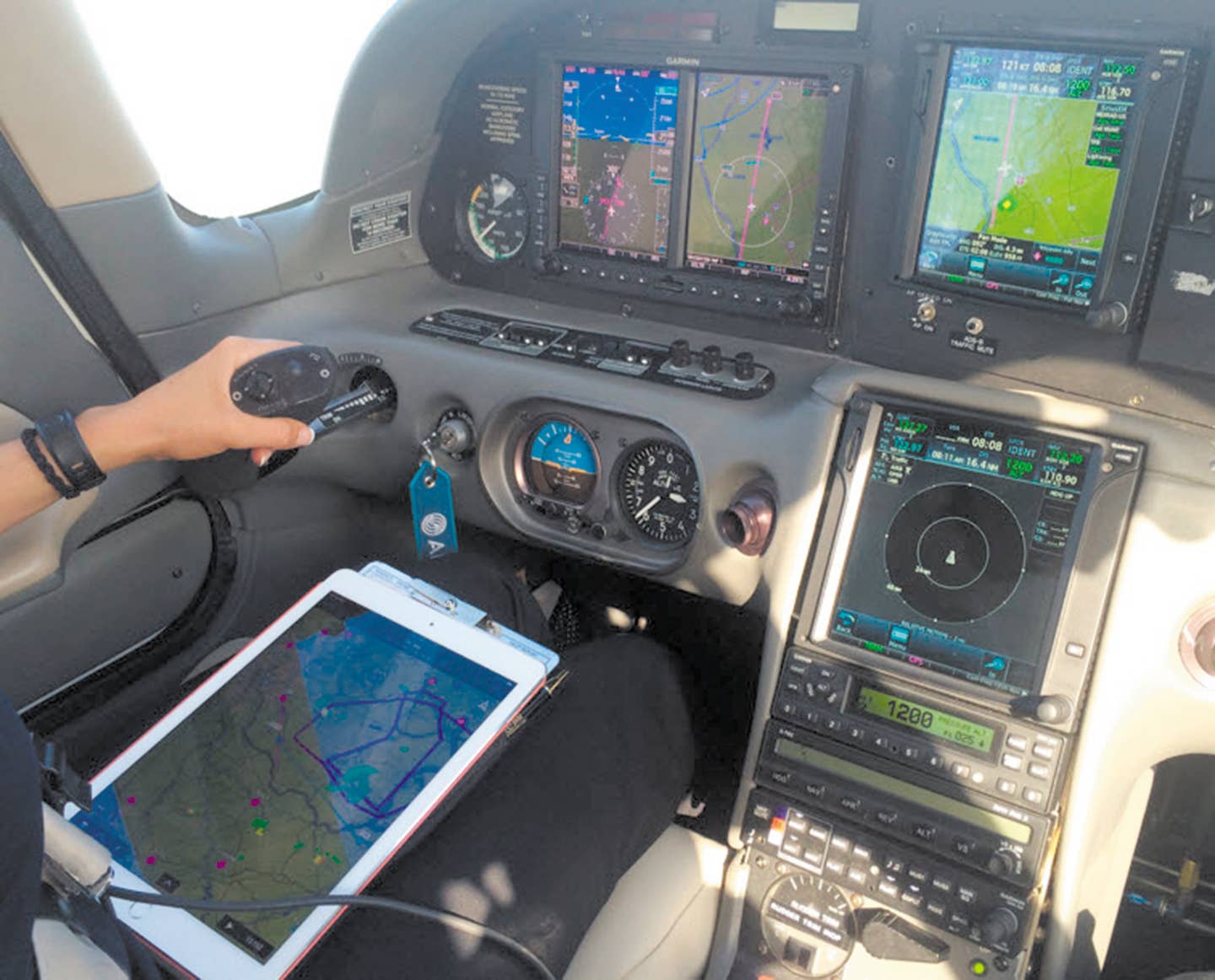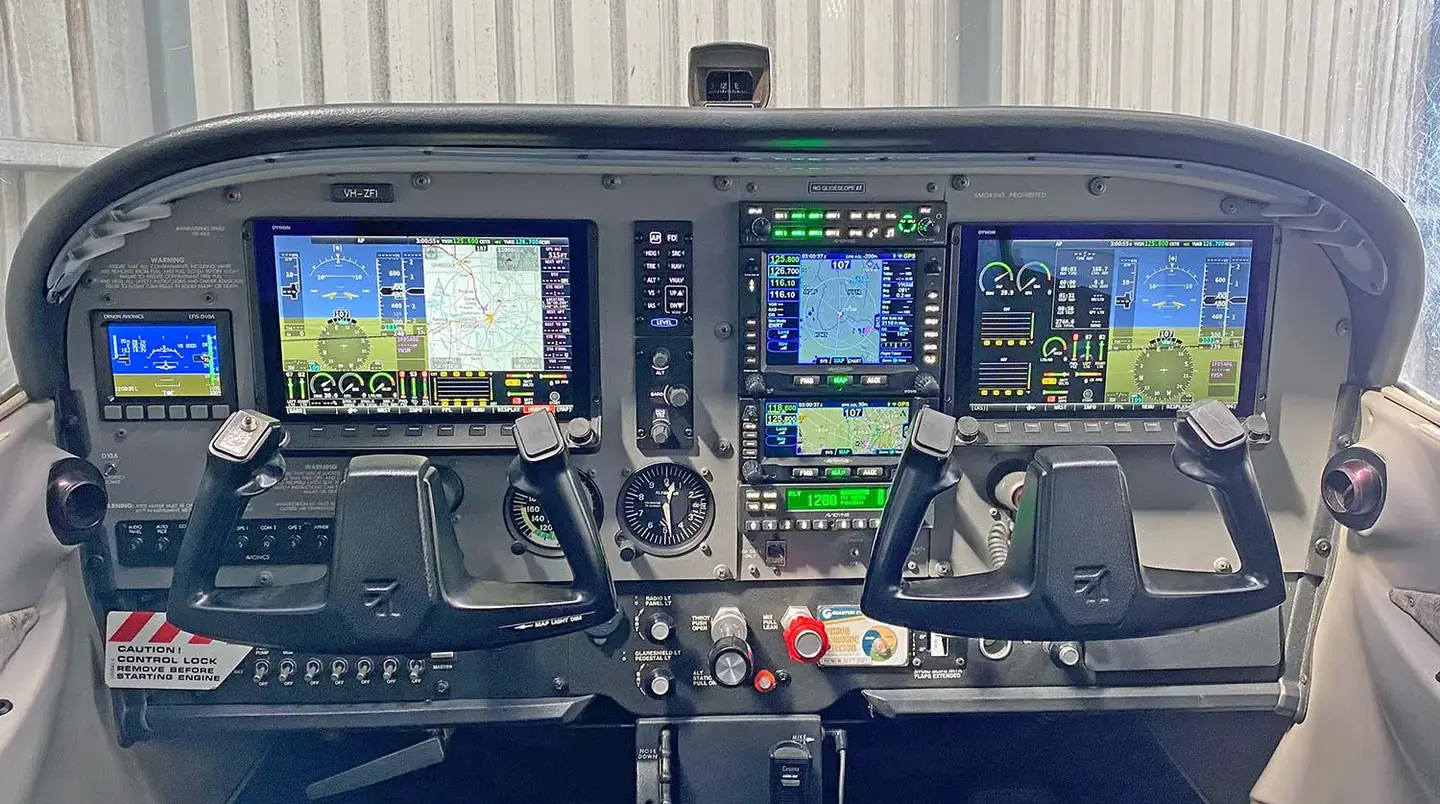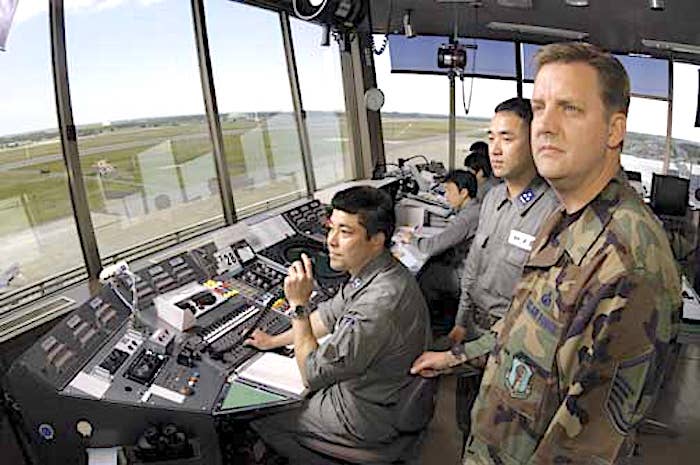Partial Panel In The Glass Age
Before glass panels, specifically Primary Flight Displays (PFD) and Multi-Functional Displays (MFD), partial panel in round-gauge, six-pack panels meant losing the attitude (AI) and heading (HI) indicators as a result…

A typical upgraded panel that approximates the configuration for Airplane A defined in the accompanying table.
Before glass panels, specifically Primary Flight Displays (PFD) and Multi-Functional Displays (MFD), partial panel in round-gauge, six-pack panels meant losing the attitude (AI) and heading (HI) indicators as a result of losing the only vacuum pump. We dreaded when the CFII or examiner pulled out those pesky round rubber instrument covers with suction cups and announced: “you just lost the vacuum pump.”
While a practical way to simulate vacuum pump failures, realistically, such a failure would be more insidious. As the gyros slowly wound down to a dead stop, along the way they would indicate “interesting” attitudes on the AI and result in even more interesting flight excursions.
In the above situation, we were left with the airspeed indicator, altimeter, electric turn coordinator, vertical speed indicator (VSI), and a magnetic compass. In IMC, it’s a true emergency, especially in turbulence, because aircraft attitude had to be inferred from these remaining instruments—a high workload.
Some Improvements
Prior to PFDs, three upgrades occurred. Newer panels were fitted with a visible indicator that the vacuum pump failed, an improvement over the nondescript peanut-sized suction indicator. To avoid the single-point-of-failure mode, some airplanes have been fitted with a second vacuum pump, electrically or engine driven.
With Advisory Circular 91.75 (June 2003), the FAA allowed the exchange of the turn coordinator with an electric attitude indicator. However, this exchange resulted in losing the slip/skid ball and impacted an associated rate-based autopilot. In the latter situation, the turn coordinator had to be retained.
Airman Certification Standards
What is required of the pilot for an instrument practical or an instrument proficiency check (IPC) regarding partial panel? Referencing FAAS-ACS-8B (with Change 1) VII. Emergency Operations: Task D. Approach with Loss of Primary Flight Instrument Indicators; Complete a nonprecision instrument approach without the use of the primary flight instruments using the skill elements of the nonprecision approach. (Note: nonprecision approaches are covered in Task VI A.)
The pilot must be able to aviate (aircraft control) and navigate (following a track). While not explicitly stated is the ability to communicate with ATC via voice and not just by squawking 7700 or 7600. Obviously, this would take last place in terms of criticality.
Glass Panel Implications
Because of a lack of mechanical gyros and spinning vacuum pumps, solid-state avionics are perceived to be more reliable. While logical, data comparing this perceived reliability is illusive. However, even modern glass avionics sometimes have bad days, and the associated failures can be multiple.
While there are many options of glass retrofit and OEM avionics, where do we start addressing partial panel flying in the age of glass? In the pre-glass days, partial panel definition was simple: losing the AI and HI due to vacuum pump failure. As noted, we lost the ability to aviate in the normal way, but usually we had the ability to navigate and communicate. Of course, I’m not implying that it was easy to aviate by inferring aircraft attitude from the remaining instruments. With glass, we might lose the ability to aviate, navigate, and communicate.
A PFD typically includes attitude indicator (AI), airspeed, altimeter, slip/turn indicator, rate of turn indicator, heading and course deviation, and glideslope as part of an HSI display. The PFD could also provide other information such as outside temperature (OAT), ground speed, wind direction, and true airspeed. But none of these additional items are critical to maintaining aircraft control.
A PFD usually has three input components: ADC (air data computer), an attitude & heading reference system (AHRS), and a magnetometer. In some installations, the ADC is combined with the AHRS resulting in ADAHRS or ADHRS. Each of these can fail on its own, resulting in some loss of capability.
Typical Glass Installations
Since it would be difficult to consider all combinations of glass installations, for practical purposes, let’s consider three common installations. We’ll look at possible failure modes, and how best to simulate partial panel for training and IPC purposes. Nothing of what follows should be used in lieu of the approved Pilot Operating Handbook (POH) avionics supplement and any required documents provided by the avionics manufacturer.
Before considering the three glass installations, note the table below represents an installation that meets the definition of a Technically Advanced Airplane (TAA) Generation 1.
| Technically Advanced Airplane (TAA) Generation 1: |
|---|
| 1. Six-pack flight instruments but with an EHSI (electronic horizontal situation indicator), which incorporates a mini moving map and a vacuum-driven attitude indicator. |
| 2. Traditional nav/com radios (nothing fancy). |
| 3. IFR WAAS GPS with a mini moving map. |
| 4. Mode S extended squitter transponder with ADS-B In, with Bluetooth WX and traffic to a tablet aviation app. The transponder also has an Attitude & Heading Reference System (AHRS), with Bluetooth to a PFD on the tablet app. |
| 5. Attitude-based two-axis autopilot with nav and approach capabilities. |
This configuration is not true glass but satisfies the definition of a TAA Generation 1: A moving map display, an IFR GPS, and an autopilot. However, for the purposes of training for the commercial pilot single-engine airplane certificate, the FAA has defined a TAA as having a PFD, an MFD, IFR GPS, and two-axis autopilot; additionally, the PFD and MFD must be continuously visible (FAR 61.129 (j)). In other words, the above airplane cannot be used for the purposes of FAR 61.129 (3)(ii) for the commercial certificate.
Partial panel with the loss of both AI and eHSI would be like partial panel with classic round gauges. It requires having to infer attitude with the remaining instruments; however, in an emergency, an app on a tablet can provide additional attitude information.
The three aircraft avionics configurations in the table below are considered TAA Generation 2 and meet the airplane requirements for the commercial pilot certificate.
| Three Typical TAA Avionics Configurations Generation 2 |
|---|
| Airplane A reflects avionics retrofit and has the following: |
| 1. Garmin G500 PFD and MFD. |
| 2. Garmin GTN touch screen navigators (VLOC and WAAS-GPS) with comm. |
| 3. Attitude based two-axis autopilot with nav and approach capabilities. |
| 4. Back up instruments consisting of traditional round gauge: AI, altimeter and airspeed indicator next to the G500. |
| 5. Mode S extended squitter transponder with ADS-B In with Bluetooth WX and traffic to a tablet using an aviation app such as ForeFlight or Garmin Pilot. The transponder also has an Attitude & Heading Reference System (AHRS) with Bluetooth PFD information to the tablet. |
| 6. The G500 display, ADC and AHRS have different circuit breakers. |
| 7. Engine instruments are separate from the G500 PFD and MFD. |
| Airplane B also reflects avionics retrofit and has the following: |
| 1. Garmin G500TXi PFD and MFD. |
| 2. Garmin GTN touch screen navigators (VLOC and GPS) with com. |
| 3. Attitude-based two-axis autopilot with nav and approach capabilities. |
| 4. Backup instrument is an electronic mini-PFD providing attitude, altimeter, airspeed, heading, nav (VLOC and GPS) with battery backup. |
| 5. Mode S extended squitter transponder with ADS-B In with Bluetooth WX and traffic to a tablet. The transponder also has an Attitude & Heading Reference System (AHRS) with Bluetooth PFD information to a tablet. |
| 6. The G500TXi has only one circuit breaker, cannot isolate the display, ADC and AHRS. |
| 7. Engine instruments are part of the G500TXi. |
| Airplane C has the following avionics installed by the airplane manufacturer: |
| 1. Garmin G1000, PFD, and MFD including controls for com and nav. |
| 2. Attitude based autopilot. |
| 3. Mode S extended squitter transponder. |
| 4. Backup instruments consist of: AI, altimeter and airspeed. |
While these three installations (A, B, and C) reflect a small segment of glass, they have many potential failure modes. For now, let’s focus on the failure of the PFD/MFD.
Can I Aviate?
This is a fundamental question because it refers to basic aircraft control during partial panel operations. It addresses the cliché: “can I keep the shiny side up?” Communications and navigation are typical of secondary importance. We can always squawk 7700, and if we have communications we can always get radar assistance in a pinch. But in the worst case, especially for purposes of partial panel during an IPC, can we aviate and navigate. Typically, com is not an issue in the instrument ACS in partial panel operations.
Summarizing partial panel in the Age of Glass, there are many failure modes and each can be the result of different root causes. Additionally, we may have many “minor” failures such as loss of oil pressure indication due to a faulty instrument. Also, each failure mode can create secondary and tertiary effects. This creates a large number of possibilities and combinations.
Let’s focus on the loss of the PFD in the three airplanes since this closely refers to instrument ACS: “Loss of Primary Flight Instrument Indicators”.
The Recommendation
The following training scenario may result in negative reader comments. But if we can handle the worst-case situation, anything less than a worst-case would be easier to deal with.
With a glass panel of any flavor, fly in smooth VMC, near a nontowered airport, and pull the circuit breakers (CB) of the PFD, MFD, AHRS, and ADC and see what it’s like to fly in the worst-case situation. With the G500TXi, there is only one CB; the G500 and G1000 have several CBs to accomplish the same goal. However, first, pull the CBs on the ground. Then restore power and see how long it takes for everything to come back online. I have done this in all three installations mention here (first on the ground and then in flight), and everything comes back online on the ground and in-flight within a minute. In flight, just have to keep the wings level.
After pulling the CBs, you must be able to aviate at least; then, depending on the installation, maybe navigate and communicate. If you have the capability of a PFD/MFD on a tablet, use that as an additional source of information.
Summary
In this example we showed Garmin equipment, but there are others including Aspen and Avidyne. If you’re considering an avionics upgrade, don’t just focus on the “new glass stuff” but consider back-up options both in terms of equipment and location on the panel. The latter is especially critical if viewing requires neck gymnastics or excess head movements, think about other placement alternatives.
Take some time to ponder what will be lost in the scenarios suggested here, and how you will respond and adjust.
Luca Bencini-Tibo ATP/CFII, is a FAASTeam Lead Rep, aircraft owner and recipient of the Wright Brothers Master Pilot Award.
This article originally appeared in the April 2020 issue of IFR Refresher magazine.
For more great content like this, subscribe to IFR Refresher!






